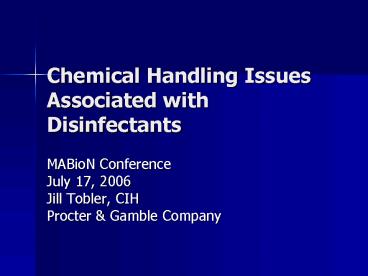Chemical Handling Issues Associated with Disinfectants - PowerPoint PPT Presentation
1 / 16
Title:
Chemical Handling Issues Associated with Disinfectants
Description:
Effectiveness against the potential pathogenic agent. Environment it ... Oxide), Mutagenic (Ethylene Oxide), Teratogenic (Ethylene Oxide), Other Target Organs: ... – PowerPoint PPT presentation
Number of Views:109
Avg rating:3.0/5.0
Title: Chemical Handling Issues Associated with Disinfectants
1
Chemical Handling Issues Associated with
Disinfectants
- MABioN Conference
- July 17, 2006
- Jill Tobler, CIH
- Procter Gamble Company
2
Selection of Disinfectants
- Effectiveness against the potential pathogenic
agent - Environment it will be used in
- Impact on equipment
- Impact on surfaces
- Clean or Dirty situation
- Cost
- Safety to people
3
Disinfectant Categories
- Liquid Chemicals
- Vapors/Gases
- Heat
- Radiation
- Non-ionizing
- Ionizing
4
Typical Chemicals for Disinfectants
- Some Examples of Typical Chemical Disinfectants
- Glutaraldehyde
- Formaldehyde
- Hydrogen Peroxide
- Chlorhexidine
- Ethylene Oxide
- Ozone
- Sodium Hypochlorite
- Iodine
- Ethanol
- Phenolics
- Quaternary Ammonium Compounds
5
Chemical Hazard Considerations
- How toxic is the material?
- How will you be using the material?
- What concentration of the material do you have to
work with? - What are the ways it can enter your body?
- Individual susceptabilities/senstivities?
- Regulatory drivers that require more chemical
management of the material?
6
Toxicity of the Chemical
- Measures of Toxicity
- LD50
- LC50
- Measures of Exposure Limits
- 8-hour TWA (Time Weighted Average)
- STEL (Short Term Exposure Limit)
- Ceiling Limit
7
Toxicity of the Chemical
- Acute Effects
- Relatively Larger Doses, Short Duration,
Immediate Effects - Examples Corrosivity, Irritation (Sodium
Hypochlorite, Quats, Hydrogen Peroxide,
Chlorhexidine, Iodine, Ozone) - Chronic Effects
- Relatively Smaller Doses, Repeated Exposures,
Delayed Effects - Examples Carcinogenic (Formaldehyde, Ethylene
Oxide), Mutagenic (Ethylene Oxide), Teratogenic
(Ethylene Oxide), Other Target Organs - Iodine (Thyroid, Kidneys)
- Ethylene Oxide (Lungs, Nerves)
- Glutaraldehyde (CNS, Heart)
8
Chemical Toxicity vs. Hazard
- Toxicity vs Hazard
- Toxicity - Ability to cause an undesired effect
in biological system - Hazard - Likelihood of undesired effects under
conditions of use
9
How Will You Use the Chemical Disinfectant?
- Do you need to dilute a concentrated stock
solution? Or is it pre-diluted? - Is it a gas or vapor?
- (EtO, Ozone, VHP)
- Is it wiped on the surfaces or sprayed?
Fumigated? - Is it used on the benchtop or in a Biosafety
Cabinet or Fume Hood? Is it contained well enough?
10
How Can it Enter Your Body?
- Is the disinfectant absorbed
- easily through the skin?
- Nitrile gloves or Latex gloves
- OK for protection?
- Examples that are absorbed through the skin
Chlorhexidine, Formalin, Glutaraldehyde, Ethylene
Oxide, Iodine - Is it aerosolized or in gas/vapor form for
increased likelihood of inhalation?
11
Controls to Minimize Exposure
- Engineering Controls
- Substitute to a less toxic disinfectant if
possible - Work in a vented BSC/Fume Hood when possible or
other containment device.
12
Controls to Minimize Exposure
- Personal Protective Equipment
- Wear Gloves lab coat to prevent skin exposure
- Wear Respiratory Protection with appropriate
cartridges to prevent inhalation exposure where
needed. - Wear goggles/safety glasses where exposure to
mucous membranes might cause a health effect.
13
Individual Sensitivities
- Is the Disinfectant a sensitizer?
- Iodine (Lung/Skin Sensitizer)
- Glutaraldehyde (Lung/Skin Sensitizer)
- Ethylene Oxide (Skin Sensitizer)
- Formaldehyde (Lung Sensitizer)
- Chlorhexidine (Photosensitizer)
14
Regulatory Drivers?
- Chemicals that require more chemical management
per OSHA standard include - Formaldehyde
- Ethylene Oxide
- May require periodic air monitoring, training,
medical surveillance, controls
15
Regulatory Drivers
- Other regulations that should be considered
include - Storage
- Peroxides (Hydrogen Peroxide)
- Flammables (Ethanol, Formalin, Phenolics)
- Disposal
- Very toxic to aquatic organisms
- Glutaraldehyde, Chlorhexidine, Benzalkonium
Chloride, Iodine
16
Summary of Chemical Considerations
- Be sure to review the safety information of the
disinfectants you will be using. - If you have an Industrial Hygienist available to
you to review the safety information with, use
them! - Review how you plan to use the disinfectant and
identify ways to minimize inhalation and
skin/mucous membrane exposure during your review. - If a safer disinfectant for you is available and
is feasible to use for your situation, use it!

